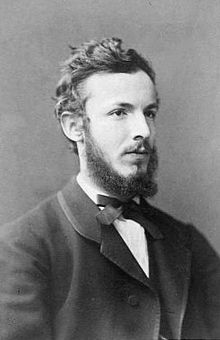
Georg Cantor, 1870
Georg Cantor was an outstanding violinist, but an even more outstanding mathematician. He was born on March 3, 1845, in Saint Petersburg, Russia, where he lived until he was eleven. Thereafter, the family moved to Germany, and Cantor received his remaining education at Darmstradt, Zürich, Berlin and (almost inevitably) Göttingen before marrying and settling at the University of Halle, where he was to spend the rest of his career.
Georg Cantor invented set theory, which has become a fundamental theory in mathematics. Cantor established the importance of one-to-one correspondence between the members of two sets, defined infinite and well-ordered sets, and proved that the real numbers are more numerous than the natural numbers. In fact, Cantor’s method of proof of this theorem implies the existence of an “infinity of infinities”. He defined the cardinal and ordinal numbers and their arithmetic. Cantor’s work is of great philosophical interest, a fact of which he was well aware.
Georg Cantor began his career by teaching in a Berlin girls’ school for a brief period of time. He then accepted a position at the University of Halle, where he spent his entire career. He joined as a lecturer in 1869 and was promoted to assistant professor in 1872, and full professor in 1879.
To attain the latter rank at the age of 34 was a notable accomplishment, but Cantor desired a chair at a more prestigious university, in particular at Berlin, at that time the leading German university. However, his work encountered too much opposition for that to be possible. Kronecker, who headed mathematics at Berlin until his death in 1891, became increasingly uncomfortable with the prospect of having Cantor as a colleague, perceiving him as a “corrupter of youth” for teaching his ideas to a younger generation of mathematicians. Worse yet, Kronecker, a well-established figure within the mathematical community and Cantor’s former professor, disagreed fundamentally with the direction of Cantor’s work ever since he intentionally delayed the publication of Cantor’s first major publication in 1874.
Georg Cantor, early 1900s
Kronecker, now seen as one of the founders of the constructive viewpoint in mathematics, disliked much of Cantor’s set theory because it asserted the existence of sets satisfying certain properties, without giving specific examples of sets whose members did indeed satisfy those properties. Whenever Cantor applied for a post in Berlin, he was declined, and it usually involved Kronecker, so Cantor came to believe that Kronecker’s stance would make it impossible for him ever to leave Halle.
Writing decades after Cantor’s death, Wittgenstein lamented that mathematics is “ridden through and through with the pernicious idioms of set theory”, which he dismissed as “utter nonsense” that is “laughable” and “wrong”. Cantor’s recurring bouts of depression from 1884 to the end of his life have been blamed on the hostile attitude of many of his contemporaries, though some have explained these episodes as probable manifestations of a bipolar disorder.
The harsh criticism has been matched by later accolades. In 1904, the Royal Society awarded Cantor its Sylvester Medal, the highest honor it can confer for work in mathematics. David Hilbert defended it from its critics by declaring: “From his paradise that Cantor with us unfolded, we hold our breath in awe; knowing, we shall not be expelled.”
In 1874, Cantor married Vally Guttmann. They had six children, the last (Rudolph) born in 1886. Cantor was able to support a family despite modest academic pay, thanks to his inheritance from his father.
The title on the memorial plaque (in Russian): “In this building was born and lived from 1845 till 1854 the great mathematician and creator of set theory Georg Cantor”, Vasilievsky Island, Saint-Petersburg.
After Cantor’s 1884 hospitalization, there is no record that he was in any sanatorium again until 1899. Soon after that second hospitalization, Cantor’s youngest son Rudolph died suddenly on December 16 (Cantor was delivering a lecture on his views on Baconian theory and William Shakespeare), and this tragedy drained Cantor of much of his passion for mathematics. Cantor was again hospitalized in 1903. One year later, he was outraged and agitated by a paper presented by Julius König at the Third International Congress of Mathematicians. The paper attempted to prove that the basic tenets of transfinite set theory were false. Since the paper had been read in front of his daughters and colleagues, Cantor perceived himself as having been publicly humiliated. Although Ernst Zermelo demonstrated less than a day later that König’s proof had failed, Cantor remained shaken, and momentarily questioning God. Cantor suffered from chronic depression for the rest of his life, for which he was excused from teaching on several occasions and repeatedly confined in various sanatoria. The events of 1904 preceded a series of hospitalizations at intervals of two or three years.
The Royal Society awarded Cantor its Sylvester Medal, the highest honor it can confer for work in mathematics, in 1904.
Cantor retired in 1913, living in poverty and suffering from malnourishment during World War I. The public celebration of his 70th birthday was canceled because of the war. In June 1917, he entered a sanatorium for the last time and continually wrote to his wife asking to be allowed to go home. Georg Cantor had a fatal heart attack on January 6, 1918, in the sanatorium where he had spent the last year of his life.
